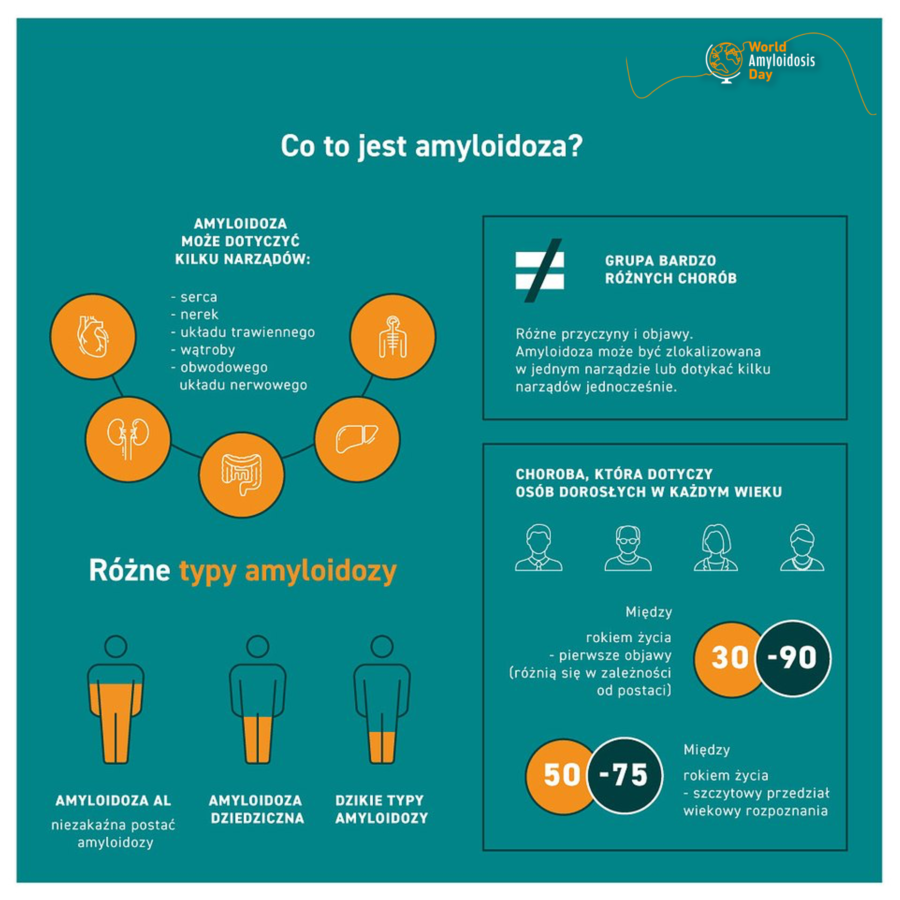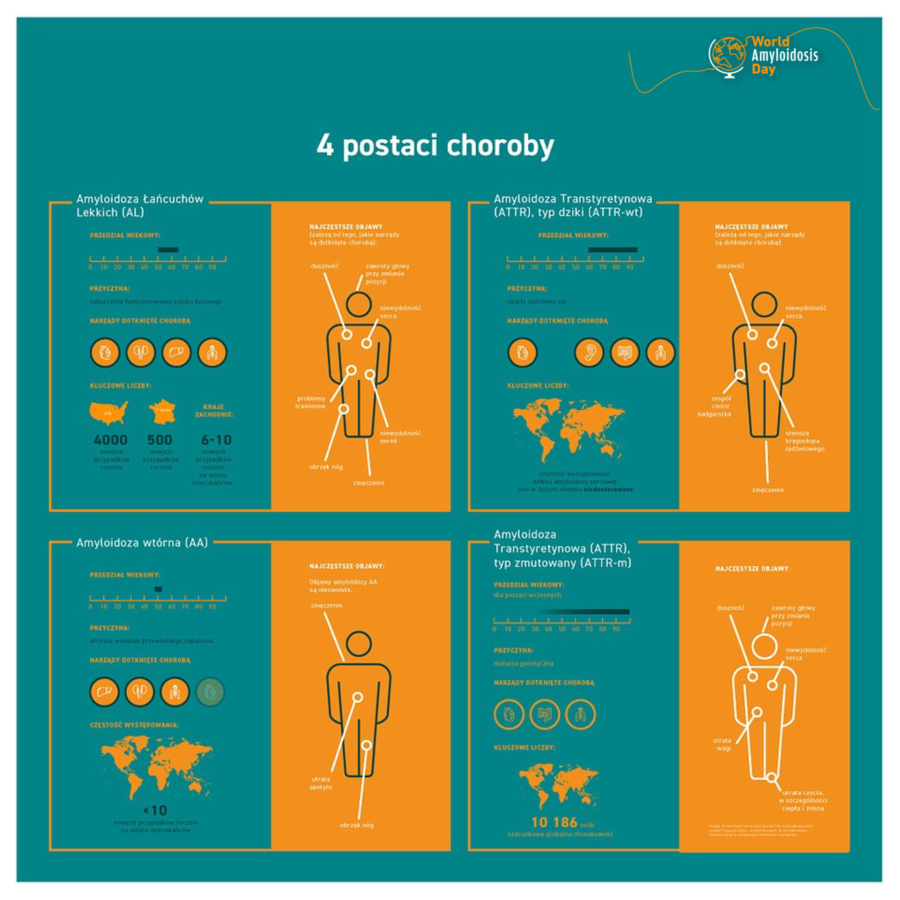This year, World Amyloidosis Day will be celebrated for the 3rd time. Its initiators want to draw attention to this mysterious and potentially fatal disease, as well as the situation of patients. The disease has several forms - one of the most insidious and dangerous is transthyretin amyloidosis, in the development of which heart failure occurs.
- A disease that has been known for 150 years until recently was diagnosed after the patient's death - today we have increasingly better options for diagnosing the disease and stopping its progression, thanks to effective drugs.
- Amyloidosis is a group of dozens of diseases, resulting from abnormal deposition of an insoluble protein called amyloid in tissues, causing damage to them
- In Poland, from July, patients suffering from light chain amyloidosisreceive treatment under an established drug programme B.145, however, dozens of patients with transthyretin amyloidosis are still waiting for the gold standard treatment and the establishment of a drug programme,
- This year, both European and Polish guidelines were published, which conclude that the only effective treatment for heart failure in transthyretin amyloidosis is transthyretin-stabilising drugs

Various forms of the disease. Amyloidosis is a group of dozens of diseases. When the protein is deposited in the heart, cardiac dysfunction and heart failure develop, and when in the nerves, peripheral polyneuropathy develops. The most common forms of the disease are light chain amyloidosis, secondary amyloidosis, and transthyretin amyloidosis (childhood or acquired type).

TTR amyloidosis is one of the better understood forms of the disease today. Transthyretin amyloidosis is an ultra-rare disease that, as experts point out, is quite unique in cardiology. It has been known for 150 years, and until recently, it was only diagnosed after the death of the patient. Today, we have the ability to diagnose this disease and stop its progression, thanks to drugs that have already been identified. The name comes from transthyretin, a protein physiologically produced by the liver, which has an important function in the body. It serves to transport retinol and thyroid hormones, among others. The accumulation of amyloid in the heart, results in the dysfunction of heart cells, as well as the infiltration of heart structures. The accumulation of amyloid in the heart results in the formation of cardiomyopathy - a disease of the heart muscle characterised by thickening of its walls and stiffness.
Misleading disease symptoms and lack of knowledge. Patients with the genetic form have symptoms, depending on the type of mutation, around 30-60 years of age, while the non-genetically determined form of ATTRwt has onset of symptoms around 65 years of age. Due to the non-specific symptoms, TTR amyloidosis often impersonates other conditions. Symptoms can range from irregular heartbeat to difficulty swallowing, shortness of breath, severe fatigue or swelling of the legs and ankles. The disease caused by abnormal protein deposition is one of the most commonly misdiagnosed in the world. However, a correct diagnosis is very important: for this rare disease is deadly and, if untreated, lethal. If untreated or inadequately treated, cardiomyopathy leads to heart failure and consequently death of the patient.
The lack of awareness of the disease among doctors is very low, and this does not make things easier for patients. As the results of a US study show, only 10 per cent of patients were diagnosed with amyloidosis by their first specialist, and up to one-quarter of patients were examined by at least five doctors from different specialities before a diagnosis of amyloidosis emerged. This, according to experts, is unacceptable at a time when available therapies can significantly improve the daily lives of patients and their loved ones and increase life expectancy. Early recognition of the disease is very important - the disease progresses, amyloid is continually deposited in the heart muscle and progression of heart failure symptoms begins. In the late stage of the disease, there are no longer any treatment options.
Key causal treatment. Early diagnosis of TTR amyloidosis and initiation of optimal therapy is crucial. The average survival time for patients from diagnosis is 2 - 6 years and the median survival from diagnosis, without causal treatment, is 2.5- 3.5 years. Lack of causal treatment shortens survival and significantly generates costs due to the need for numerous hospitalisations. Causal treatment is the only possible studied, effective and safe therapeutic option for these patients. The standard treatment is the administration of transthyretin-stabilising drugs. Currently, however, due to lack of access to causal therapy, patients with transthyretin amyloidosis in Poland are forced to use only symptomatic treatment, i.e. drugs used to treat circulatory insufficiency - such treatment may not only be poorly tolerated, but is also ineffective.
Causal treatment as the standard of care for ATTR. The European Society of Cardiology (ESC) guidelines published earlier this year unequivocally recommend transthyretin-stabilising drugs in patients with transthyretin amyloidosis as causal treatment to improve prognosis in this very special group of patients. Also published at the end of September, the Polish Society of Cardiology's expert panel guidelines on the diagnosis and treatment of this disease entity indicate that transthyretin-stabilising drugs are currently the only effective treatment for heart failure in the course of transthyretin amyloidosis.
Dozens of patients are still waiting for this standard of treatment in Poland. In Poland, since July, patients with light chain amyloidosis have been receiving treatment under the established B.145 drug programme; however, dozens of patients with transthyretin amyloidosis are still waiting for the gold standard treatment and the establishment of a drug programme. Access to effective treatment for cardiomyopathy in the treatment of this form of the disease remains a huge unmet need. Enabling access to patients in Poland, to causal treatment, is the first real chance to extend the lives of patients with the cardiac form of ATTR.
Poland remains one of the few European countries without access to effective treatment for patients with transthyretin amyloidosis. Access to effective treatment is already provided to sufferers in 19 countries such as Germany, Luxembourg, Austria, Slovenia, Finland, France, Italy, Belgium, Romania, Sweden, Iceland, Switzerland, Lithuania, Ireland, Portugal, the Netherlands, Norway, Greece and Croatia. In addition, reimbursement proceedings are underway in further countries including Estonia, Hungary, Spain, Scotland to increase access to this therapy. In Poland, the UK and Denmark, a reimbursement application is in progress.

